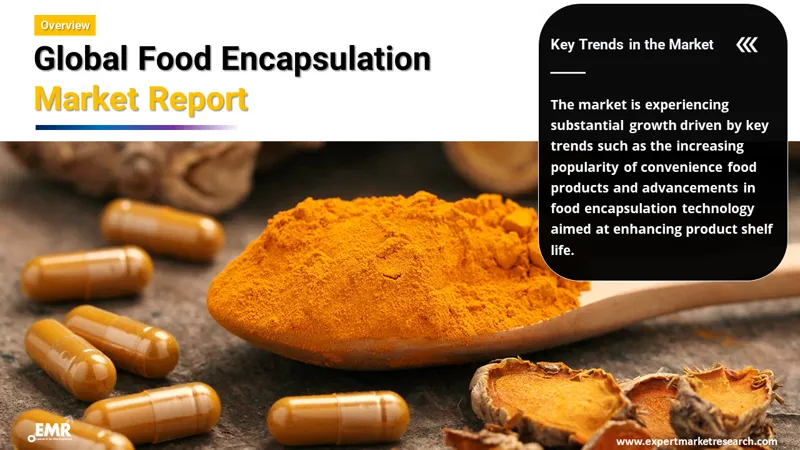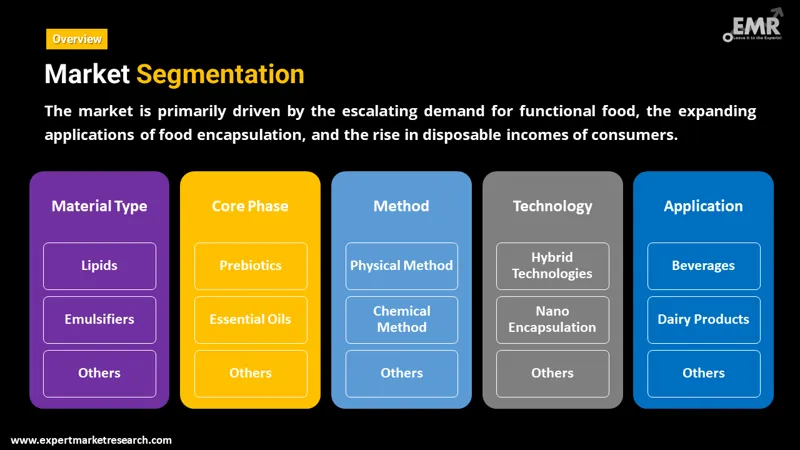
Consumer Insights
Uncover trends and behaviors shaping consumer choices today
Procurement Insights
Optimize your sourcing strategy with key market data
Industry Stats
Stay ahead with the latest trends and market analysis.
The global food encapsulation market size reached a value of approximately USD 12.89 Billion in 2025. The market is further expected to grow at a CAGR of 7.30% between 2026 and 2035, reaching a value of USD 26.08 Billion by 2035.
Base Year
Historical Period
Forecast Period
Compound Annual Growth Rate
7.3%
Value in USD Billion
2026-2035
*this image is indicative*
Food encapsulation refers to the process of incorporation of enzymes, food ingredients, and cells, among other materials into small capsules. This process is usually conducted for masking unwanted flavours and for protecting healthy ingredients. Encapsulated ingredients find applications in food product categories including ready to eat snacks, confectionary, convenience food, dairy, functional foods, and beverages, among others. This process is implemented for highly volatile ingredients such as phytonutrients, essential oils, probiotics, sweeteners, and antioxidants.

Read more about this report - REQUEST FREE SAMPLE COPY IN PDF
The EMR’s report titled “Global Food Encapsulation Market Report and Forecast 2026-2035” offers a detailed analysis of the market based on the following segments:
Market Breakup by Material Type
Market Breakup by Core Phase
Market Breakup by Method
Market Breakup by Technology
Market Breakup by Application
Market Breakup by Region

Read more about this report - REQUEST FREE SAMPLE COPY IN PDF
Microencapsulation technology is expected to occupy a sizable share of the market for food encapsulation over the forecast period as microencapsulation aids in incorporation of new functional properties in designed food products and provides protection to unstable bioactive components. As aids in protecting sensitive compounds, it is growing in demand for their safe delivery, increasing the demand for microencapsulation is in the food and pharmaceutical industries. In the coming years, technological advancements and varied functioning and advantages of the microencapsulation technology are projected to propel the growth of the market for food encapsulation globally.
The North America region holds a significant share of the market for food encapsulation, aided by the growing popularity of the convenience foods in the region due to the busy lifestyles led by people and widespread acceptance of convenience foods. The demand for long lasting flavours is also fuelling the growth of the market for food encapsulation in the North America region, supported by a growing preference for specialised food products due to rising disposable incomes and increasing health awareness.
The comprehensive EMR report provides an in-depth assessment of the market based on the Porter's five forces model along with giving a SWOT analysis. The report gives a detailed analysis of the following key players in the global food encapsulation market, covering their competitive landscape and latest developments like mergers, acquisitions, investments, and expansion plans.
Kerry Group plc is a food and beverage services company that was established in 1972 and is headquartered in Tralee, Ireland. They are one of the world leaders in the food and beverage and pharma industries with manufacturing and innovation centres in various countries around the globe.
BASF SE is a chemical manufacturing company that was founded in 1865 and is based in Ludwigshafen, Germany. The company is dedicated towards creating a sustainable future with the help of chemistry with a portfolio that comprises of materials, chemicals and nutrition and care, among others.
International Flavors & Fragrances Inc. established in 1958 and headquartered in New York, United States, is a chemical manufacturing company. They are one of the global leaders in the health and biosciences, and food beverage industries as well as sensorial experiences.
*Please note that this is only a partial list; the complete list of key players is available in the full report. Additionally, the list of key players can be customized to better suit your needs.*
Other market players include Cargill, Incorporated, Koninklijke DSM N.V., Ingredion Incorporated, Symrise AG, Balchem Corporation, Encapsys, LLC, FrieslandCampina Kievit, and Vitablend Nederland BV, among others.




*While we strive to always give you current and accurate information, the numbers depicted on the website are indicative and may differ from the actual numbers in the main report. At Expert Market Research, we aim to bring you the latest insights and trends in the market. Using our analyses and forecasts, stakeholders can understand the market dynamics, navigate challenges, and capitalize on opportunities to make data-driven strategic decisions.*
Get in touch with us for a customized solution tailored to your unique requirements and save upto 35%!
The market size reached a value of approximately USD 12.89 Billion in 2025.
The market is expected to grow at a CAGR of 7.30% between 2026 and 2035.
The market is estimated to witness a healthy growth in the forecast period of 2026-2035 to reach USD 26.08 Billion by 2035.
The major market drivers are the increasing demand for functional food, growing applications of food encapsulation, and rising disposable incomes of consumers.
The key trends fuelling the growth of the market include growing popularity of convenience food products and advancements in food encapsulation in order to increase the shelf life of products.
The various applications of food encapsulation include functional foods, dietary supplements, bakery products, confectionary products, beverages, frozen products, and dairy products.
The significant materials types of food encapsulation in the market are polysaccharides, proteins, lipids, and emulsifiers, among others.
The key players in the global food encapsulation market are Kerry Group plc, BASF SE, International Flavors & Fragrances Inc., Cargill, Incorporated, Koninklijke DSM N.V., Ingredion Incorporated, Symrise AG, Balchem Corporation, Encapsys, LLC, FrieslandCampina Kievit, and Vitablend Nederland BV, among others.
Explore our key highlights of the report and gain a concise overview of key findings, trends, and actionable insights that will empower your strategic decisions.
| REPORT FEATURES | DETAILS |
| Base Year | 2025 |
| Historical Period | 2019-2025 |
| Forecast Period | 2026-2035 |
| Scope of the Report |
Historical and Forecast Trends, Industry Drivers and Constraints, Historical and Forecast Market Analysis by Segment:
|
| Breakup by Material Type |
|
| Breakup by Core Phase |
|
| Breakup by Method |
|
| Breakup by Technology |
|
| Breakup by Application |
|
| Breakup by Region |
|
| Market Dynamics |
|
| Competitive Landscape |
|
| Companies Covered |
|
Datasheet
One User
USD 2,499
USD 2,249
tax inclusive*
Single User License
One User
USD 3,999
USD 3,599
tax inclusive*
Five User License
Five User
USD 4,999
USD 4,249
tax inclusive*
Corporate License
Unlimited Users
USD 5,999
USD 5,099
tax inclusive*
*Please note that the prices mentioned below are starting prices for each bundle type. Kindly contact our team for further details.*
Flash Bundle
Small Business Bundle
Growth Bundle
Enterprise Bundle
*Please note that the prices mentioned below are starting prices for each bundle type. Kindly contact our team for further details.*
Flash Bundle
Number of Reports: 3
20%
tax inclusive*
Small Business Bundle
Number of Reports: 5
25%
tax inclusive*
Growth Bundle
Number of Reports: 8
30%
tax inclusive*
Enterprise Bundle
Number of Reports: 10
35%
tax inclusive*
How To Order

Select License Type
Choose the right license for your needs and access rights.

Click on ‘Buy Now’
Add the report to your cart with one click and proceed to register.

Select Mode of Payment
Choose a payment option for a secure checkout. You will be redirected accordingly.
Gain insights to stay ahead and seize opportunities.

Get insights & trends for a competitive edge.

Track prices with detailed trend reports.

Analyse trade data for supply chain insights.

Leverage cost reports for smart savings

Enhance supply chain with partnerships.

Connect For More Information
Our expert team of analysts will offer full support and resolve any queries regarding the report, before and after the purchase.
Our expert team of analysts will offer full support and resolve any queries regarding the report, before and after the purchase.
We employ meticulous research methods, blending advanced analytics and expert insights to deliver accurate, actionable industry intelligence, staying ahead of competitors.
Our skilled analysts offer unparalleled competitive advantage with detailed insights on current and emerging markets, ensuring your strategic edge.
We offer an in-depth yet simplified presentation of industry insights and analysis to meet your specific requirements effectively.
Share